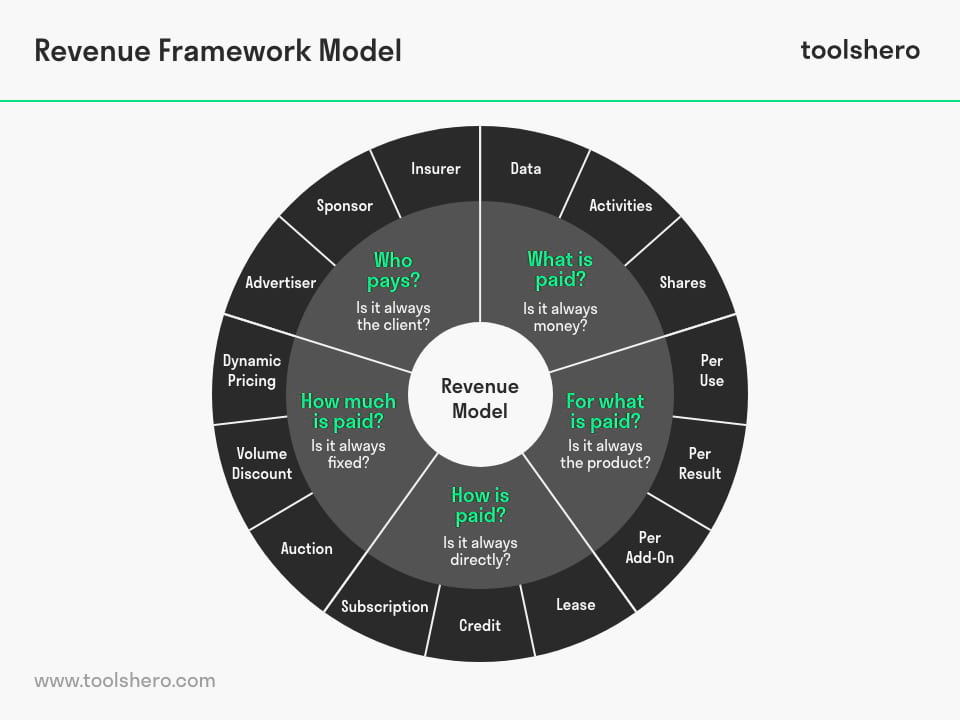Revenue Model Framework

What are the different ways my organization can generate income?
Key Definitions
All organizations need money to function and therefore require means to generate sufficient income. An organization’s revenue model is the specific manner by which it acquires these funds – it is the way that the organization gets paid.
In a typical company, the implicit standard approach is that revenue comes from selling products or services to customers, who directly pay the list price in cash. Yet, besides this ‘default revenue model’ there are many different ways of generating income.
Conceptual Model
The revenue model framework outlines the five categories of choices that together make up a revenue model. Each category is formulated as a question around payment, with three common examples mentioned of alternatives to the default option. Each set of three examples is not exhaustive, so more possibilities exist in each of the five categories, but the categories themselves are exhaustive and all need to be addressed.
Key Elements
Key Elements
The five revenue model categories that need to be determined are:
- WHO pays?. From whom does the money flow? Even if we say ‘the client’ it can be the case that it is not the actual user transferring the funds, but the user’s mother, or the budget holder or the procurement department. And looking beyond the actual client it could be a:
A. Advertiser. Paying for the opportunity to promote something else.
B. Sponsor. Paying to support something/someone unable to generate enough funds.
C. Insurer. Paying out some risk covered by insurance. - WHAT is paid?. Can the client pay with something different than money? Since the time of bartering we have been used to exchanging goods for something different that financial tokens. Typical alternatives to monetary income include:
A. Data. Paying by giving (personal) data to the supplier.
B. Activities. Paying by performing (small) services for the supplier.
C. Shares. Paying by giving a part of future revenue streams to the supplier. - FOR WHAT is paid?. What does the client get for the payment? Besides paying and receiving the product/service (pay per product), clients can also pay based on receiving some other benefit, such as paying:
A. Per use. Paying only for the actual times or intensity of usage.
B. Per result. Paying only for the outcome achieved.
C. Per add-on. Paying only for the extras on top of the base product. - HOW is paid?. By what means does the payment take place? In the default situation, it is a straight-forward exchange, with ownership being acquired by paying the entire amount directly in full. But payment can also be by:
A. Lease. Paying for exclusive use of a product for a certain period.
B. Credit. Paying for a product/service in instalments over a certain period of time.
C. Subscription. Paying for access to a shared product/service for a certain period. - HOW MUCH is paid?. By what method is the price to be paid determine? Of course, everyone knows that in many situations the list price is just the first bid in a negotiation process. But besides fixed pricing and negotiations, prices can also be determined by:
A. Auction. Paying the price set in a multi-party bidding process.
B. Volume discount. Paying a price calculated by the volume of products purchased.
C. Dynamic pricing. Paying a price calculated by time, place, demand and availability.
Key Insights
- Strong default revenue model. When thinking how to get paid, companies often implicitly start from the ‘normal’ situation of asking the prospective user to directly pay the listed price for the product or service. This default model can easily block thinking about alternatives.
- Revenue models have five dimensions. Every revenue model must answer the questions ‘who pays?’, ‘what is paid?’, ‘for what is paid?’, ‘how is paid?’ and ‘how much is paid?’. It ‘pays’ to consider each question explicitly, instead of following the default model.
- Every revenue model dimension has many options. Within each revenue model dimension there are many options possible, with only some of the most popular ones presented here as examples.
- Striving for multiple revenue streams. When designing a revenue model, companies shouldn’t limit themselves to one option per dimension. It makes sense to consider offering payers multiple options (e.g. pay-per-product or pay-per-use), as well as developing multiple revenue streams, by putting together a (sub-)revenue model per payer category.
- Integral part of the business model. Designing a revenue model is not a stand alone activity, but an integral part of determining the organization’s business model. It is a strategic activity, not one that can be left to operational decision-makers.
How to cite this article:
Meyer, R. (2019). Revenue Model Framework. Retrieved [insert date] from toolshero: https://www.toolshero.com/strategy/revenue-model-framework/
Add a link to this page on your website:
<a href=”https://www.toolshero.com/strategy/revenue-model-framework/”>toolshero: Revenue Model Framework</a>












